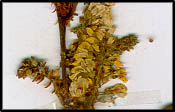South West Slopes Revegetation Guide
Daviesia latifolia
Hop Bitter-pea
Select from the following for detailed images.
Species Information
| Synonyms |
|
| Common Names |
Hop Bitter-pea |
| Family |
Fabaceae - Pea family. |
| Name Origin |
Daviesia - after botanist the Rev. Hugh Davies (1739-1821). latifolia - from Latin latus, broad, and folium, leaf, referring to broad 'leaves'. |
Specimen Data - CSU 1028
| Location |
Roadside, Falls Creek - Mount Beauty Road, Alpine National Park Victoria. |
| Notes |
Zone: 55 Easting: 523695 Northing: 5921954 |
| Collector |
Kent, Kylie & Lunt, Ian |
Date |
24/11/1999 |
| Determined By |
Lunt, Ian |
Date |
24/11/2000 |
South West Slopes Revegetation Guide Information
| Regional: |
Quite widespread, predominantly east of the Hume Highway. |
| Australia: |
Qld, NSW, Vic, Tas. |
| Habitat: |
Dry sclerophyll communities and woodland, to 1800 m altitude. |
| Habit: |
Open shrub 1-3 m high (rarely to 5 m). Broad dull green 'leaves' and many tough erect branches. |
| Similar Species: |
|
| Site Preference: |
|
| Characteristics: |
|
| Flowering: |
Orange-yellow with dark reddish markings, Sep-Dec. Showy. |
| Seed Collection: |
Early Dec to late Jan. Monitor very closely as seeds released immediately or 1-2 days after maturity. To ensure collection, cover fruiting branches with nylon stockings or paper bags after flowering. When ripe, pods light-brown and brittle and rattle when shaken, with dark-coloured seed. May be difficult to obtain seed in useful quantities. Long storage life. |
| Propagation: |
From scarified seed. Soak in near-boiling water for about 30 seconds, before cooling rapidly under flowing cold water. Alternatively soak in cold water for several hours. Dry to prevent rotting, before sowing. Germination takes |
| Regeneration: |
From seed or suckers, particularly after fire. Other Daviesia species establish well from direct seeding, although seed shortages may preclude this method. |
| Timber: |
|
| Shade and Shelter: |
Useful low-level cover in windbreaks. |
| Land Protection: |
Useful understorey in recharge plantings, and for improving soil fertility, through 'fixing' nitrogen. |
| Wildlife: |
Good habitat. Flowers provide pollen and excellent nectar, food for various insects and native birds. |
| Ornamental: |
Very decorative with interesting foliage and attractive perfumed flowers. Plant in clumps to form dense thickets for best effect. |
| Other: |
'Leaves' and stems produce fawn dye with alum as mordant. 'Leaves' have medicinal properties and were substituted for hops. Reputedly used as drug that expels intestinal worms by European settlers. 'Leaf' decoction taken to expel hydatid cysts, and also as tonic. |
Note: The following information presented is only a guide, as plant characteristics vary depending on provenance (the plant's locality).
| Site/Preferred Habitat : |
well-drained soils |
| Rainfall(mm) : |
500 |
| Growth Rate : |
fast |
| Tolerates : |
frost; full sun |
| Resents : |
poor drainage |
| Uses & Comments : |
windbreak; recharge control; fixes nitrogen; wildlife; ornamental |
Return to Database List
